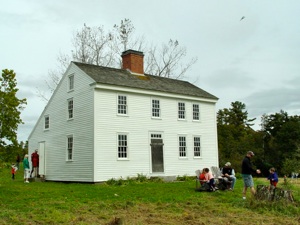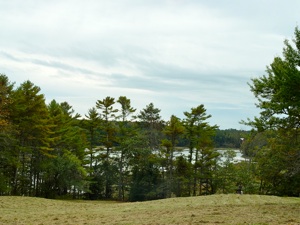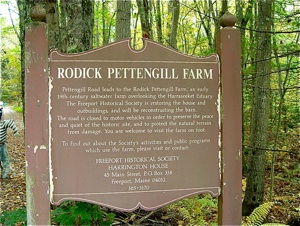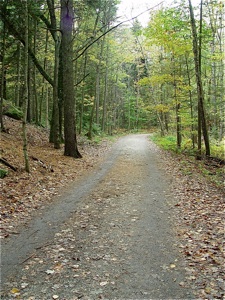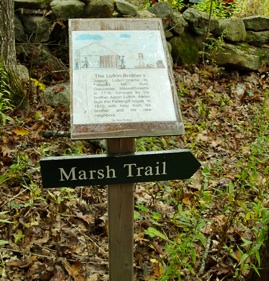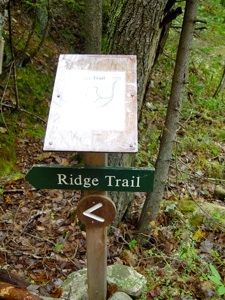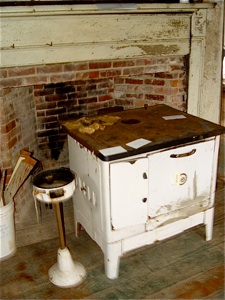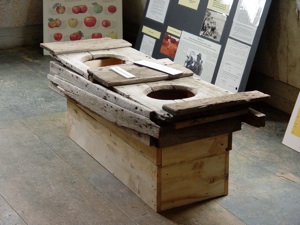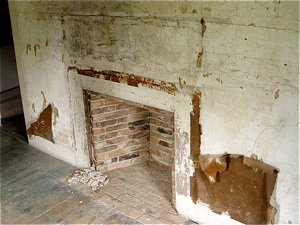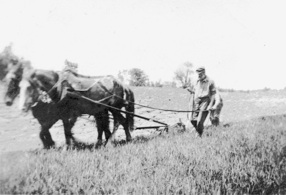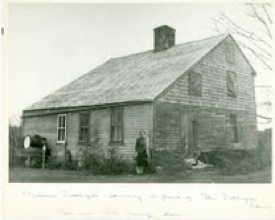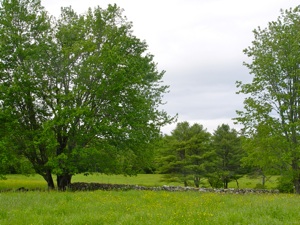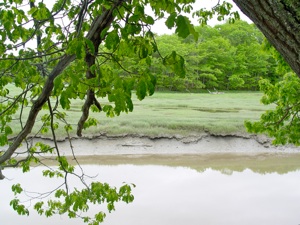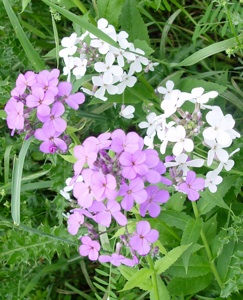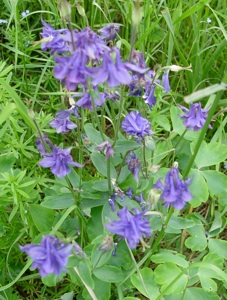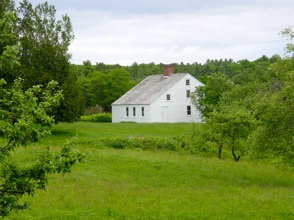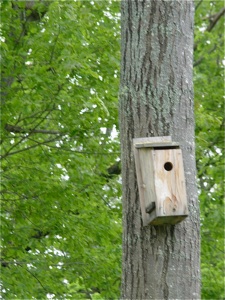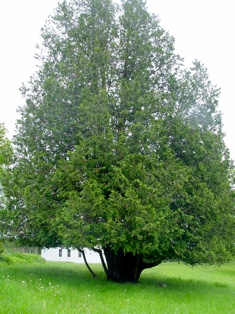Name: Pettengill Farm
Farm Address: Pettengill Farm
Pettengill Road
Freeport, Maine
Freeport Historical Society Address:
Freeport Historical Society
45 Main Street
Freeport, Maine 04032
Phone: 207-865-3170
Email:
info@freeporthistoricalsociety.org
Website:
www.freeporthistoricalsociety.org
Products and Services:
-four walking trails
-gardens
-fields and woods
-salt marsh
-vista to saltwater Harraseeket estuary
-historic saltbox house
-antique apple orchards
Open Hours for Pettengill Farm:
-grounds are open dawn to dusk year-round
-saltbox farmhouse open by appointment
-Annual Pettengill Farm Day - 1st Sunday in Oct.
Open Hours For Freeport Historical Society:
-Public Exhibit Hours - 10 a.m. - 5 p.m.
-Administrative Office Hours - 8:30 a.m. -5 p.m.
What Makes Pettengill Farm So Unique?
The story of Pettengill Farm is interwoven with the themes of perseverance, self-sufficiency, and love
of the land. If you have had the opportunity to
visit this Freeport farm with its fields, forests, salt marsh, and access to the estuary of the Harraseeket River, you are well aware of the incredibly beautiful surroundings. The simple 1800 farmhouse stands alone on the ridge overlooking the water.
There were not many original saltbox houses built in Maine, so the Pettingill Farmhouse is highly prized from an architectural standpoint. It was included in the National Register of Historic Places in 1973. Its simplicity evokes a picture of a much earlier time when people farmed for their food and livelihood and got by with few conveniences.
One of the most remarkable aspects of the house is that no plumbing, electricity, central heat, or phone, were ever installed. Mildred Pettengill was the last resident. She left the farm in 1970. After a senseless vandalism in 1975, the house was renovated, but it has been preserved with relatively few changes. It is considered a rare historic treasure for several factors and has received much recognition because of the the sgraffitti - the historic drawings that cover three walls in the upstairs of the house. There are artistic renderings of four ships associated with the war of 1812, and pictures of men, and sea monsters that were etched into the plaster.
The Pettengill family’s connection with the land began in 1858, when Charles Henry Pettengill purchased the farm and land. His son and daughter-in-law, Wallace and Adelaide, raised three children on the farm - Ethel, Frank, and Mildred. Mildred (Millie) was born on the farm in 1882. As a youngster she experienced loss at an early age. Her mother died in the front room of the farmhouse in 1893, when Millie was only ten years old.
Millie’s older sister, Ethel, who was twenty-three years of age at the time of their mother’s death, took over the household chores. Sadly, Ethel passed away three years later, leaving thirteen-year-old Millie to begin a lifelong existence on the farm as the sole female. Her father, Wallace, died in February 1925. Pettengill Farm formed the essence of life for Millie and her brother Frank. The farm was their home, their basic source of food, and what occupied their day-to-day existence.
Architectural historian Ursula Baier conducted interviews with Millie in 1973, when Millie was 81 years old and living with her nephew, Russell, in Standish. These interviews were recorded. The tapes and Ursula’s notes are now housed at the Freeport Historical Society. The notes proved extremely helpful to the Unique Maine Farms’ project in providing insight into Millie and in acquiring an idea of the critical role that the farm played in the lives of Millie and Frank.
During the interview with Ursula Baier, Millie recounted how her mother and sister always made butter. They sold cream and fed the milk to the pigs. She explained how Frank took their milk in five and ten gallon milk cans in a wagon led by their horse to the railroad in Freeport where it was shipped on the train. Most of the buildings on the farm were built by her brother, Frank. There was a stable, barn, five hen houses, a privy, and a milk house. Ice was cut by hand and covered with sawdust to cool the milk in the milk house.
Frank had worked at other farms and also for the railroad in his early years, but when their father fell off the barn and was hurt in the early 1890‘s, Frank returned home and Pettengill Farm remained his focus for the rest of his life.
Frank and Millie were very self-sufficient. They sold or bartered potatoes, wood, pigs, milk, cream, butter and apples. Millie stated that they did not go to the doctor. Crisp plantain leaves were used in a tea for stomach ailments and weeds and bitters were brewed. Becoming sick from botulism was never an issue. Some of the few items that the Pettengills purchased included cloth, flour, and meal to make johnny cakes.
Pigs, oxen, ducks, horses, geese and chickens were raised by Frank and Millie. A butcher came to the farm to slaughter the pigs. Meat from the animals was salted in barrels and canned in glass jars and kept for use in the winter. Corn cobs were used as the fuel in barrels for the smoking of the ham from the white Jeresey pigs. Fishermen gave cunners and flounder and other fish to Frank and Mildred that they canned. Vegetables were preserved and stored in the cellar. Clams were also canned. Millie explained that the clams were so plentiful that they were often fed to the chickens!
Cooking originally took place in the house at the fireplace with the bake oven and the crane with the stew pot. A wood stove was acquired to heat the house and then replaced by an oil stove in the 1940’s. The oil stove was delivered by truck, but the horsehair sofa in the farmhouse was hauled to the farm by a boat. Kerosene was used for the lamps. Water had to be hauled in buckets.
Oxen were originally used around the farm, but they were considered to be too slow so they were replaced by horses. The Pettengills raised Jersey, Ayrshire, and Guernsey cows for milk. They usually kept a dozen cows or more and a bull. They originally stored the milk in the cellar, but when the regulations about selling milk became more stringent, they had to build a milk room. The cows were watered from the gulleys on the property as they contained “never-ending springs.”
Dairy farmers in the area were forced to stop harvesting the salt marsh hay because of complaints that it unfavorably flavored the milk. Frank and Millie had used the salt marsh hay for winter feed and to bank up the house. Oxen had been used to harvest the salt hay which was dried on shore.
Frank and Millie raised their own beans for baked beans and stewed beans. Millie reminisced about how the corn they grew was exceptionally tall. The ensilage corn was ground for the chickens. Oats were grown and a threshing machine that was driven by horses was hired by the Pettengills for the threshing. Millet was mowed by hand and fed green in the fall to the animals.
Animals and the trees and plants on the farm were a very important part of Millie’s life. She spoke with great fondness of the dogs and cats that became her close companions. She tended the gardens and enjoyed the cypress and apple trees that flourished on the property. The white lilac that she planted at the end of the house proved very dear to Millie. It had come from Staples Point in South Freeport. Her brother had planted the purple lilacs and some shade trees. Some of the flowers that she cultivated included phlox, columbines, bouncing bet, and daffodils.
Millie raised seventeen varieties of roses. She commented that the hollyhocks near the outhouse “looked so good.” She had a reputation for her mastery of botany. She saved seeds. Her cherished columbines came from her grandfather and they still can be spotted growing throughout the field in front of the house. The bell flower apple tree with the yellow apple with a slight red blush on it was one of her favorites. Millie also had a rock collection. The farm was run with organic practices. The orchard was never exposed to sprays. Millie explained that the pigs served the function of cleaning the apples under the tree and that this prevented worms.
The Harraseeket River played a significant role in
the Freeport area before the Pettengills settled at the farm. Harraseeket Landing (later named Mast Landing) was a busting economic center in the early days. With the advent of industrialization several farms in the area were no longer actively farmed. Tidal power was utilized to run the grist, shingle, and saw mills. There were five brickyards on the river. Frank carried several of the disfigured bricks back to the farm and Millie incorporated them in her gardens. The brick paths can still be seen. Millie and Frank had a boat and she shared how she paddled all around visiting her cousins and friends.
The documentary Words from Millie’s Garden - The Story of Pettengill Farm, by Ronald J. Gillis of Cousin River Productions is a wonderful tribute to Millie and Frank and Pettengill Farm. There is a heartwarming section about how a young neighbor boy named Matthew Brown helped Millie and Frank celebrate a Christmas one year. There is also information about the twenty-three letters that were written to Millie from Jack Harvey who appeared interested in marrying her when she was thirty-one. The documentary is available for sale at the Freeport Historical Society or by contacting Ron Gillis at Cousins River Productions.
Walking was always one of Millie’s favorite activities. According to the Gillis’s documentary, Millie walked Bradbury Mountain in her ninetieth year! While growing up she walked to the elementary school located at the end of the road. Getting to secondary school involved a two mile-walk as the high school was situated in the town of Freeport. Millie was a strong student who was very interested in studying botany, history, literature, and math. Books were highly prized and Millie enjoyed visiting the library near Codman Tavern. Each Sunday she would walk to the Congregational Church. She acquired a camera in the 1920’s and enjoyed documenting things taking place at the farm.
When the weather turned cold, Millie would bring the fish in her garden fishpond to the spring below the house to spend the winter. Wood was harvested to feed the woodstove for heat in the cold weather. Seaweed was collected as banking for the house to protect it from the wind. Mildred shared that sometimes it was so cold in the house that the water in the tea kettle actually froze.
Both Millie and Frank never married and spent many years together working the farm. Eleanor Houston and Lawrence Smith, wealthy preservationists, were fascinated with their lifestyle and the significance of the saltbox house and farm. In 1959, they purchased the farm with the understanding that Frank and Millie could reside at the farm for as long as they wished. Frank Pettengill died in 1960. The loneliness and many challenges with running a farm were exacerbated for Millie with her brother’s passing.
The Smith’s foreman, Charlie, was checking over the property one day when he found Millie in a pitiful state in a freezing house sitting next to her dog who had died. She had been living in a tent inside the house to keep warm. The Smiths knew it was time for other living arrangements for Millie. She was welcomed by her relatives and she left the farm in 1970. Those who knew her well will share that her heart and spirit always remained with the house and land, and her flowers, trees and gardens. Thanks to the foresight and generosity of the Smiths, the farm property was donated to the care of the Freeport Historical Society.
Without running water, electricity, or a phone for all of her years on the farm, many individuals might feel that Millie Pettingill lived a poor and unfulfilling life. The story of Millie and her brother Frank is an intriguing one. In the interviews conducted by Ursula Baier with Millie in 1973, it became very clear that Mildred felt she lived a very full life. She would explain that not having access to modern conveniences was simply a lifestyle to which she always had been accustomed.
While the stunning views, the gardens, fields, woods, and estuary all offered a beautiful place to live, Ursula Baier shared that Millie’s life was far from idyllic. Ursula had been hired by the Smiths to interview Millie because they wished to have some of the history of the farm documented. Ursula said that the interviews were extremely challenging because Millie was reluctant to answer many questions that were posed from a stranger. According to Ursula, Millie covered her mouth with her hand and mumbled. Ursula felt that Millie was a very lonely woman who desperately missed the farm towards the end of her life. She passed away in 1981 at ninety-eight years of age.
A visit to Pettengill Farm is well worth the effort.
The property is open to the public every day from dawn to dusk. There are four walking trails, stunning views, fields, and forests, and the estuary and river. The house itself is only open to the public on the Annual Pettengill Farm Day on the first Sunday in October or by appointment. There are special historical demonstrations that take place at the Open House Day and the property is alive with activity. Even a visit when access to the house is not possible, is well worth the effort. There is a chance that you may be the only visitor exploring the 140 acre property, but you will not feel alone. There is a sense that Millie Pettengill is still around with the apple orchards, brick path, large white lilac, and all the colorful flowers.




